Surely, it does not look pretty at all. So, you might want to change
this default login page. In order to do this, first let us create an
empty SharePoint project in Visual Studio 2010. After that, add an
application page by right click-selecting “Add New Item” and you will
get like the following window in Solution Explorer:
Notice that, when you add any application page to your project, Visual Studio automatically creates aLayouts folder.
To keep things simple enough for your understanding, you may keep your
application page under a folder where you might name it as same as your
project like the figure above.
Now, add a reference for Microsoft.SharePoint.IdentityModel in your project. Open the application page, and add an assembly for that on the top of your application page Beofre the Page tag, you should have the following section in your application page:
<%@ Assembly Name="$SharePoint.Project.AssemblyFullName$" %>
<%@ Assembly Name="Microsoft.SharePoint, Version=14.0.0.0, Culture=neutral, PublicKeyToken=71e9bce111e9429c" %>
<%@ Assembly Name="Microsoft.SharePoint.IdentityModel, Version=14.0.0.0, Culture=neutral, PublicKeyToken=71e9bce111e9429c" %>
<%@ Assembly Name="Microsoft.SharePoint, Version=14.0.0.0, Culture=neutral, PublicKeyToken=71e9bce111e9429c" %>
<%@ Assembly Name="Microsoft.SharePoint.IdentityModel, Version=14.0.0.0, Culture=neutral, PublicKeyToken=71e9bce111e9429c" %>
<%@ Import Namespace="Microsoft.SharePoint" %>
<%@ Import Namespace="Microsoft.SharePoint.WebControls" %>
<%@ Import Namespace="Microsoft.SharePoint.WebControls" %>
<%@ Register Tagprefix="SharePoint"
Namespace="Microsoft.SharePoint.WebControls"
Assembly="Microsoft.SharePoint, Version=14.0.0.0, Culture=neutral, PublicKeyToken=71e9bce111e9429c" %>
<%@ Register Tagprefix="asp" Namespace="System.Web.UI"
Assembly="System.Web.Extensions, Version=3.5.0.0, Culture=neutral, PublicKeyToken=31bf3856ad364e35" %>
Namespace="Microsoft.SharePoint.WebControls"
Assembly="Microsoft.SharePoint, Version=14.0.0.0, Culture=neutral, PublicKeyToken=71e9bce111e9429c" %>
<%@ Register Tagprefix="asp" Namespace="System.Web.UI"
Assembly="System.Web.Extensions, Version=3.5.0.0, Culture=neutral, PublicKeyToken=31bf3856ad364e35" %>
Now look ContentPlaceHolderID="PlaceHolderMain" and add a literal control and Login Control like the following:
<SharePoint:EncodedLiteral runat="server"
EncodeMethod="HtmlEncode" ID="ClaimsFormsPageMessage"
Visible="false" />
<asp:Login ID="signInControl"FailureText="<%$Resources:wss,login_pageFailureText%>"
runat="server" Width="100%" DisplayRememberMe="true"BackColor="LightCyan" BorderColor="DarkGreen" ForeColor="DarkBlue"InstructionText="Use KFUPM Internet Account to Login"InstructionTextStyle-ForeColor="DarkGreen" InstructionTextStyle-Font-Size="Small" />
EncodeMethod="HtmlEncode" ID="ClaimsFormsPageMessage"
Visible="false" />
<asp:Login ID="signInControl"FailureText="<%$Resources:wss,login_pageFailureText%>"
runat="server" Width="100%" DisplayRememberMe="true"BackColor="LightCyan" BorderColor="DarkGreen" ForeColor="DarkBlue"InstructionText="Use KFUPM Internet Account to Login"InstructionTextStyle-ForeColor="DarkGreen" InstructionTextStyle-Font-Size="Small" />
Now, you can obviously customize according to your needs here. That’s it
and our custom page is ready to use. So, save and deploy the project.
After that, go to central administration->Application Management->Manage Web Application: select your web application for which you have enabled Form based authentication and click on Authentication Providers. Click on Default where a window will pop up and scroll down where you will see a section Sign In Page URL; select Custom Sign In Page and the path will be as the following format:
~/_layouts/ [Project name] / [Application Page Name].aspx
The following is the screenshot for my project:
Save it and go to your site collection/site login page which is using this FBA web app. When you will click on Sign In, you should get a page like the following one:
Custom Web Part for signing in Form Based (Claims Based) Web applications:
You have seen until now that how can you create a custom login page for
your FBA web application. Now, to improve the functionality like most of
the public facing websites, you might want to put this login panel on
the home page. Let us now discuss about creating a custom web part which
will leverage us this option from home page where you can just add that
webpart anywhere you like. So, let us get started.
Open Visual Studio 2010 and create an Empty SharePoint Project. To
achieve our goal, we can add a normal web part or a visual web part to
our project (Depending on the privilege of having the access to deploy
the solution as Farm or Sandboxed). For this instance, I have chosen
Farm based solution. So, I have added a Visual Web Part in my project
(which is not possible in sandboxed solutions). [In your case, if you
do not have sufficient privilege, you can add a normal webpart and
create the UI inside theCreateChildControls method of your webpart.]
Now, add the following references to your project:
Microsoft.IdentityModel
Microsoft.IdentityModel.WindowsToeknService
Microsoft.SharePoint.IdentityModel
For visual web part, add the Assembly name inside the .ascx page.
<%@ Assembly Name="Microsoft.SharePoint.IdentityModel, Version=14.0.0.0, Culture=neutral, PublicKeyToken=71e9bce111e9429c" %>
Now, add a login control to this ascx page like below and customize it according to your needs:
<asp:Login runat="server" ID="FBALogin" BackColor="#F7F6F3"
BorderColor="#E6E2D8" BorderPadding="4" BorderStyle="Solid"BorderWidth="1px"
Font-Names="Verdana" Font-Size="0.8em" ForeColor="#333333"Height="201px"
onauthenticate="FBALogin_Authenticate" Width="390px">
<InstructionTextStyle Font-Italic="True" ForeColor="Black" />
<LoginButtonStyle BackColor="#FFFBFF" BorderColor="#CCCCCC"BorderStyle="Solid"
BorderWidth="1px" Font-Names="Verdana" Font-Size="0.8em"ForeColor="#284775" />
<TextBoxStyle Font-Size="0.8em" Width="100px" />
<TitleTextStyle BackColor="#5D7B9D" Font-Bold="True" Font-Size="0.9em"
ForeColor="White" />
</asp:Login>
BorderColor="#E6E2D8" BorderPadding="4" BorderStyle="Solid"BorderWidth="1px"
Font-Names="Verdana" Font-Size="0.8em" ForeColor="#333333"Height="201px"
onauthenticate="FBALogin_Authenticate" Width="390px">
<InstructionTextStyle Font-Italic="True" ForeColor="Black" />
<LoginButtonStyle BackColor="#FFFBFF" BorderColor="#CCCCCC"BorderStyle="Solid"
BorderWidth="1px" Font-Names="Verdana" Font-Size="0.8em"ForeColor="#284775" />
<TextBoxStyle Font-Size="0.8em" Width="100px" />
<TitleTextStyle BackColor="#5D7B9D" Font-Bold="True" Font-Size="0.9em"
ForeColor="White" />
</asp:Login>
Notice that, I have added an event handler here FBALogin_Authenticate which will perform the authentication (see the code below)
protected void FBALogin_Authenticate(object sender, AuthenticateEventArgs e)
{
Uri webUri = new Uri(SPContext.Current.Web.Url); //Getting the current context of URL
string membershipProvider = "admembers"; //Set the FBA authentication provider
string roleProvider = "";
e.Authenticated = SPClaimsUtility.AuthenticateFormsUser(
new Uri(SPContext.Current.Web.Url),
FBALogin.UserName,
FBALogin.Password);
{
Uri webUri = new Uri(SPContext.Current.Web.Url); //Getting the current context of URL
string membershipProvider = "admembers"; //Set the FBA authentication provider
string roleProvider = "";
e.Authenticated = SPClaimsUtility.AuthenticateFormsUser(
new Uri(SPContext.Current.Web.Url),
FBALogin.UserName,
FBALogin.Password);
if (!e.Authenticated) return;
SecurityToken secTk = SPSecurityContext.SecurityTokenForFormsAuthentication(webUri, membershipProvider, roleProvider, FBALogin.UserName, FBALogin.Password);
if (secTk == null)
{
if (secTk == null)
{
e.Authenticated = false;
return;
}
else
{
return;
}
else
{
SPFederationAuthenticationModule fam = SPFederationAuthenticationModule.Current;
fam.SetPrincipalAndWriteSessionToken(secTk);
e.Authenticated = true;
fam.SetPrincipalAndWriteSessionToken(secTk);
e.Authenticated = true;
SPUtility.Redirect(SPContext.Current.Web.Url, SPRedirectFlags.Trusted, this.Context);
}
}
Adding a Link for Windows Authentication on the Custom Login Web Part:
What if you want to add a link for windows authentication as well if
your web application uses both form based and windows based
authentication. For this, I have added a link for windows authentication
on the web part.
Here below is the OnLoad event for the web part:
protected override void OnLoad(EventArgs e)
{
base.OnLoad(e);
EnsureChildControls();
SPControlMode formMode = SPContext.Current.FormContext.FormMode;
string returnUrl = "/";
{
base.OnLoad(e);
EnsureChildControls();
SPControlMode formMode = SPContext.Current.FormContext.FormMode;
string returnUrl = "/";
if (string.IsNullOrEmpty(
this.Context.Request.QueryString["ReturnUrl"]) == false)
{
returnUrl = this.Context.Request.QueryString["ReturnUrl"];
}
this.Context.Request.QueryString["ReturnUrl"]) == false)
{
returnUrl = this.Context.Request.QueryString["ReturnUrl"];
}
winLoginLink.NavigateUrl =
"/_windows/default.aspx?ReturnUrl="
+ returnUrl;
if (formMode == SPControlMode.Edit || formMode == SPControlMode.New || this.Page.User.Identity.IsAuthenticated == true)
{
DisableLoginForm();
}
"/_windows/default.aspx?ReturnUrl="
+ returnUrl;
if (formMode == SPControlMode.Edit || formMode == SPControlMode.New || this.Page.User.Identity.IsAuthenticated == true)
{
DisableLoginForm();
}
}
In this event, at first, I am checking the mode of the page whether it
is new, edit or Logged in mode. We can get the URL for the validated URL
from a query string called “ReturnUrl”.
Later on, I am setting the navigation URL link for the windows
authentication and based on the page mode, hiding the login form which
will hide the web part if the current page is in Edit, New or Logged In
mode.
private void DisableLoginForm()
{
this.EnsureChildControls();
{
this.EnsureChildControls();
this.FBALogin.Enabled = false;
this.FBALogin.VisibleWhenLoggedIn = false;
this.FBALogin.VisibleWhenLoggedIn = false;
DisableLoginValidator(this.FBALogin, "UserNameRequired");
DisableLoginValidator(this.FBALogin, "PasswordRequired");
winLoginLink.Visible = false;
DisableLoginValidator(this.FBALogin, "PasswordRequired");
winLoginLink.Visible = false;
}
Above code will hide our web part based on the context mode of the page.
I will also need to disable the login validator which is provided
below:
private static void DisableLoginValidator(
Login loginControl,
string validatorID)
{
Debug.Assert(loginControl != null);
Debug.Assert(string.IsNullOrEmpty(validatorID) == false);
Login loginControl,
string validatorID)
{
Debug.Assert(loginControl != null);
Debug.Assert(string.IsNullOrEmpty(validatorID) == false);
RequiredFieldValidator validator = loginControl.FindControl(
validatorID) as RequiredFieldValidator;
validatorID) as RequiredFieldValidator;
if (validator != null)
{
validator.Enabled = false;
}
}
{
validator.Enabled = false;
}
}
Now, we are ready to go. Deploy it on your target site or site
collection where you will use this web part. After adding the web part
on the page, it will appear as following screenshot:

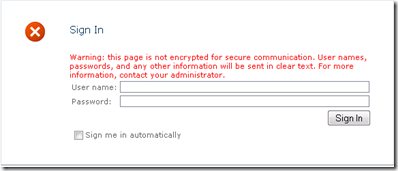
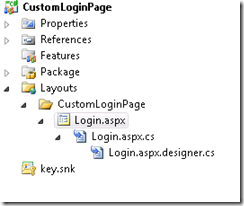
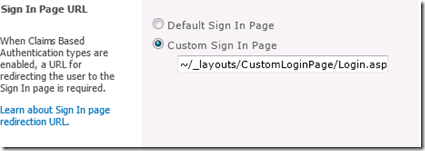
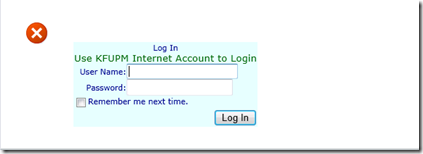
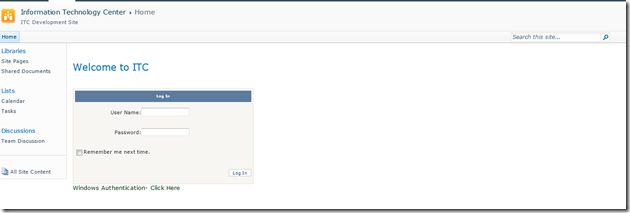
No comments:
Post a Comment